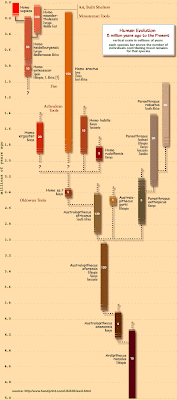 You'll need to click on this image to see a version you can read. The chart shows the known historical existence of humans and sixteen other hominids, plus a number of inferred relationships. I obtained this image from Ancestral Lines (handprint.com).
You'll need to click on this image to see a version you can read. The chart shows the known historical existence of humans and sixteen other hominids, plus a number of inferred relationships. I obtained this image from Ancestral Lines (handprint.com).It is most likely that, if Homo antecessor is ancestral to H. sapiens, its ancestor species is either H. ergaster or an un-found species intermediate between the two. Alternatively, H. antecessor could have branched from H. erectus by population isolation. The smaller population would have diverged the most, while the large population remained comparatively stable. Indeed, H. erectus seems to have been stable for a longer period than any of the others that are shown. It is likely that there are dozens of hominid species yet to be discovered, though a good number of them might have left no fossil remains at all.
As I considered this chart, I realized that the genus Ardipithecus may be the direct descendant of the common ancestor species of humans and chimpanzees. It is at most one or two species removed. Then I realized that, if we could find the fossils, the evolutionary path leading to chimps is probably just as complex as the human one. Finding proto-chimp fossils is much less likely than proto-humans because chimps live in more humid environments.
A September 2005 article in the Washington Post (here) reports on the sequencing of the chimpanzee genome, all three billion base pairs. The number of differences between chimp and human comes to forty million, or 1.3 percent. While most of these are probably SNP's (single nucleotide polymorphisms), a number of larger changes and rearrangements also exist. For example, chimps have 48 chromosomes and humans have 46. Further, the scientists are reported to have a list of 250,000 DNA changes that define the differences between the two species. That is 0.6% of the changes, which seems a reasonable number; it is about one-third of the ratio of coding to non-coding DNA: coding DNA is about 2% of the total in both species (and a tiny fraction is regulatory DNA which doesn't code for proteins but controls DNA coding or produces RNA that does so).
I call that reasonable because changes happen more freely and usually without consequence in non-coding (and non-regulatory) DNA, while DNA that codes for proteins or regulatory sequences is resistant to change because so many of the changes are deleterious.
Within the human species, each of us carries a million or so molecular changes to our DNA, including the three or four thousand that affect "real stuff" and make us visibly and behaviorally unique. These account for human diversity (The amount of genetic diversity among chimpanzees is much greater, but I haven't seen a particular value).
Backing off a few more steps, it seems logical that every species living today has a similarly bushy "family tree" that lies behind its existence. This is why paleontologists say that only a tiny fraction of fossil species will ever be found. We're lucky to have the fossils we do have!



No comments:
Post a Comment